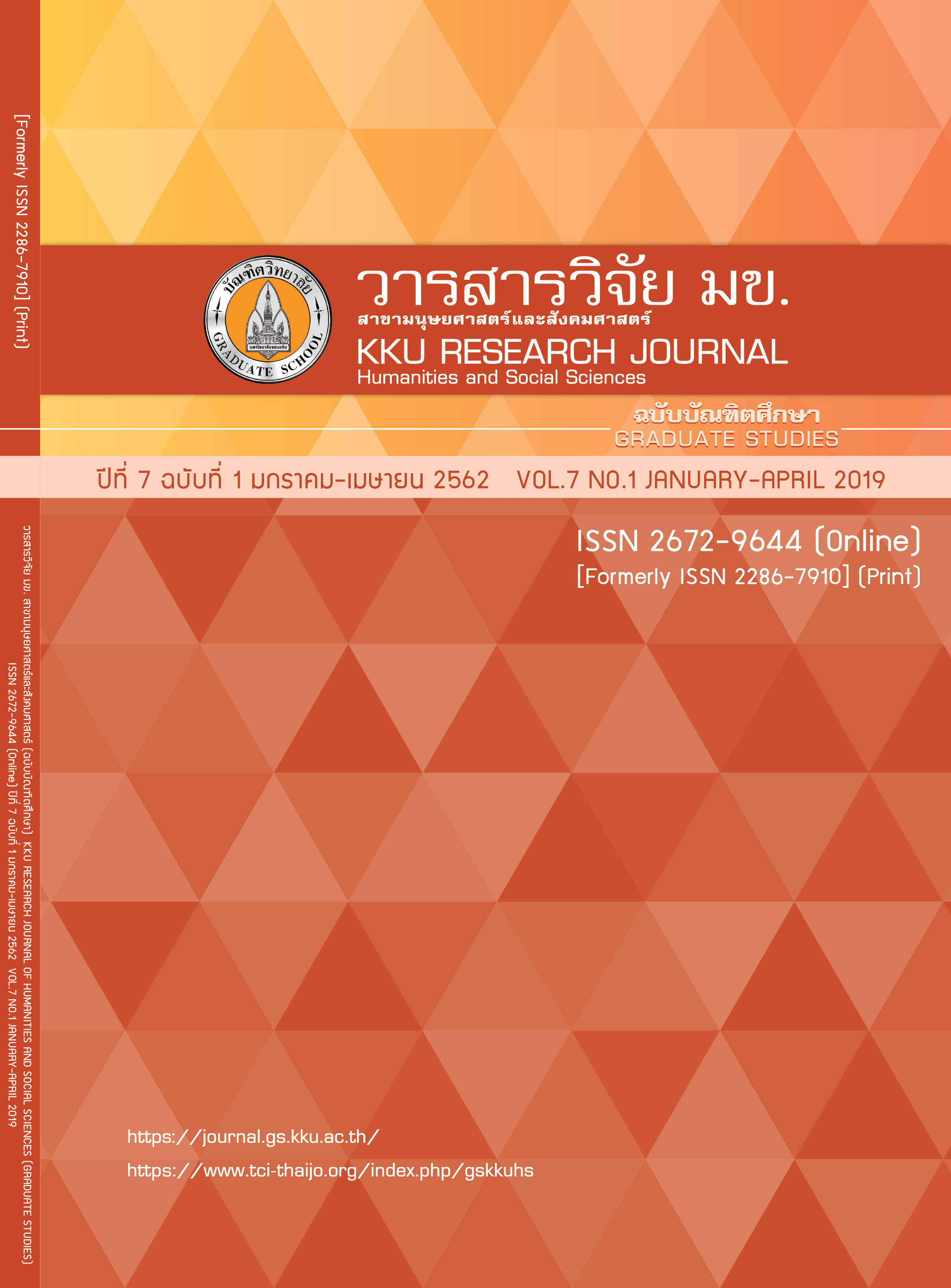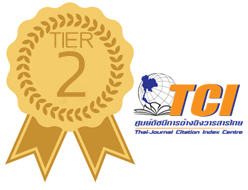ความสัมพันธ์ระหว่างบุคลิกภาพห้าองค์ประกอบ ความสามารถในการกลับคืนสู่ สภาพเดิม กับภาวะหมดไฟในการทำงานของพนักงานระดับปฏิบัติการ บริษัทธุรกิจพลังงานแห่งหนึ่ง
คำสำคัญ:
บุคลิกภาพห้าองค์ประกอบ, ความสามารถในการกลับคืนสู่สภาพเดิม, ภาวะหมดไฟในการทำงานบทคัดย่อ
การศึกษาครั้งนี้มีวัตถุประสงค์เพื่อศึกษาความสัมพันธ์ระหว่างบุคลิกภาพห้าองค์ประกอบ ความสามารถในการกลับคืนสู่สภาพเดิม กับภาวะหมดไฟในการทำงาน ของพนักงานระดับปฏิบัติการ บริษัทธุรกิจพลังงานแห่งหนึ่ง กลุ่มตัวอย่างที่ใช้ในการศึกษาครั้งนี้คือ พนักงานระดับปฏิบัติการ บริษัทธุรกิจพลังงานแห่งหนึ่ง จำนวน 123 คน เครื่องมือที่ใช้ในการศึกษาคือ แบบสอบถามข้อมูลลักษณะส่วนบุคคล แบบวัดบุคลิกภาพห้าองค์ประกอบ แบบวัดความสามารถในการกลับคืนสู่สภาพเดิม และแบบวัดภาวะหมดไฟในการทำงาน สถิติที่ใช้ในการวิเคราะห์ข้อมูล คือ ค่าร้อยละ ค่าเฉลี่ย ส่วนเบี่ยงเบนมาตรฐาน และค่าสัมประสิทธิ์สหสัมพันธ์เพียร์สัน ผลการศึกษาพบว่า บุคลิกภาพห้าองค์ประกอบมีความสัมพันธ์กับภาวะหมดไฟในการทำงาน โดยบุคลิกภาพแบบหวั่นไหวมีความสัมพันธ์ทางบวกกับภาวะหมดไฟในการทำงานอย่างมีระดับนัยสำคัญทางสถิติที่ระดับ .01 บุคลิกภาพแบบแสดงตัว บุคลิกภาพแบบมีจิตสำนึก และบุคลิกภาพแบบประนีประนอมมีความสัมพันธ์ทางลบกับภาวะหมดไฟในการทำงานอย่างมีระดับนัยสำคัญทางสถิติที่ระดับ .01 และบุคลิกภาพแบบเปิดรับประสบการณ์ มีความสัมพันธ์ทางลบกับภาวะหมดไฟในการทำงานอย่างมีระดับนัยสำคัญทางสถิติที่ระดับ .05 และความสามารถในการกลับคืนสู่สภาพเดิมมีความสัมพันธ์ทางลบกับภาวะหมดไฟในการทำงานอย่างมีระดับนัยสำคัญทางสถิติที่ระดับ .01
References
2. Schaufeli WB, Martínez IM, Pinto AM, Salanova M, Bakker AB. Burnout and engagement in university students:
A cross-national study. Journal of Cross-Cultural Psychology. 2002; 33(5): 464-481.
3. Maslach C, Jackson SE, Leiter MP. Maslach Burnout Inventory. California: Consulting Psychologists; 1896.
4. Lerthattasilp T. Burnout among psychiatrists in Thailand: National survey. Journal of the Psychiatric
Association of Thailand. 2011; 56(4): 437-448. Thai.
5. Tangkittipaporn J. Psychology of personality and health behavior. Bangkok: Chulalongkorn University
Printing House; 2016. Thai.
6. Madnawat AVS, Mehta P. Personality as a predictor of burnout among managers of manufacturing industries.
Journal of the Indian Academy of Applied Psychology. 2012; 38(2): 321-328.
7. Chongvisal R. Human relations: Human behavior in organization. Bangkok: Kasetsart University
Printing House; 2011. Thai.
8. Jitbantao T. Psychology of personality. Chiang Rai: Chiang Rai Rajabhat University Printing House; 2016. Thai.
9. Warner R, April K. Building Personal Resilience at Work. Effective Executive. 2012; 15(4): 53-68.
10. Grotberg E. A Guide to Promoting Resilience in Children: Strengthening the Human Spirit. The Hague:
Bernard van Leer Foundation; 1995.
11. Murphy Y. The Role of Job Satisfaction, Resilience, Optimism and Emotional Intelligence in
the Prediction of Burnout. Dublin: Dublin Business School; 2014.
12. Ritcharoon P. Social science research methodology. Bangkok: Phranakhon Rajabhat University
Book Center; 2001. Thai.
13. Maslach C, Jackson SE. The measurement of experienced burnout. Journal of Occupational
Behaviour. 1981; 2(2): 99–113.
14. Frunzi GL, Savini PE. Supervision: The art of management. New Jersey: Prentice-Hall Inc; 1997.
15. Carod-Artal FJ, Vázquez-Cabrera C. Burnout syndrome is an international setting. Burnout for Experts:
Prevention in the Context of Living and Working. 2013; 1: 15-35.
16. Bakker AB, Van der Zee KI, Lewig KA, Dollard MF. The relationship between the Big Five
personality factors and burnout: a study among volunteer counselors. Journal of Social Psychology.
2006; 146(1): 31-50.
17. Tangsinsapsiri T. Organizational behavior (OB). Bangkok: Thanathud Printing; 2007. Thai.
18. Maslach C, Schaufeli WB, Leiter MP. Job burnout. Annual Review of Psychology. 2001; 52: 369-422.
19. Schultz DP. Psychology and Industry Today: An Introduction to Industrial and Organizational Psychology.
New York: Macmillan; 1982.
20. Arunkong S. The relationship between the big five personality factors and job burnout : a case study of
a private hospital [Master of Arts] Bangkok: Thammasart University; 2007. Thai.
21. Lerkiatbundit S. Job Burnout: Development, Definitions and Measurement. Songklanakarin
Journal of Social Sciences and Humanities. 1999; 5(2): 168-180. Thai.
22. Sanubon C, Sophonsiri S, Polyorat K. The Impact of Personality on Job Burnout and Job
Engagement of Hotel Front Office Staff. Journal of humanities and social sciences
Mahasarakham University. 2012; 31(3): 8-20. Thai.
23. Sereesitthipitak V. Burnout: Definition, inventory, prevention and intervention. Journal of
Somdet Chaopraya Institute of Psychiatry. 2007; 1(2): 121-123. Thai.
24. Gupta R, Sood S, Bakhshi A. Relationship between resilience, personality and burnout in
police personnel. International Journal of Management Sciences. 2012; 1(4): 1-5.
25. Santhosh KR, James J. The effect of resilience on burnout among the blue collared employees
in metal factories. International Journal of Multidisciplinary Management Studies. 2013; 3(6): 48-55.
26. Kotze M, Lamb S. The influence of personality traits and resilience on burnout among customer
service representatives in a call centre. Journal of Social Sciences. 2012; 32(3): 295-309.
27. Rodrigues RTS, Barbosa GS, Chiavone PA. Personality and resilience as protection against
burnout in resident doctors. Brazilian Journal of Medical Education. 2013; 37(2): 245-253.



